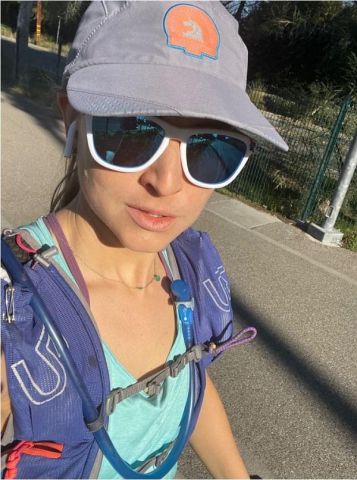Road to Boston Marathon Part 2: Exercising at Home or in the Gym
10 Exercises to Improve Strength, Conditioning, and Balance
Leading up to the Boston Marathon, I have been incorporating these 10 key exercises into my weekly routine (3x/week) to keep my body strong and balanced. Videos of these exercises are posted below. These exercises target the key muscle groups used by runners. These are for educational purposes, not meant to treat medical conditions nor supplement medical advice.
Mat-based Strength and Conditioning for Boston
- Sidelying Clamshell: strengthens your hip external rotators (gluteus maximus, piriformis, obturator internus). Be sure not to let your hips roll backwards!
- Single leg bridge with hip abduction isometric: strengthens hip extensors and knee flexors (hamstrings, gluteus maximus, and gluteus medius). Be sure to keep your spine neutral. I use a “roll-up and roll-down” technique here to ensure my back muscles don’t compensate for my hip muscles.
- Sidelying hip abduction with hip in slight internal rotation, followed by clockwise and counterclockwise hip circles: strengthens hip abductors, hip extensors, deep core muscles (gluteus medius, maximus, obliques, transverse abdominus). Don’t let your leg move forward as you do this exercise– that allows compensation with your TFL muscle (connects to IT Band) which most runners over-use!
- Sidelying Hydrant: strengthens hip abductors. I use this exercise to build endurance in the already-fatigued glute muscles at this point in my exercise.
- Side plank with shoulder circles: Strengthens obliques, transverse abdominus, shoulder stabilizers, and hip abductors. This improves trunk stability as well. Runners need strong core muscles.
Dynamic Balance and Functional strengthening:
- Front plank with reverse crunch: strengthens and builds endurance in transverse abdominis, hip flexors, obliques, shoulder stabilizers. This movement mimics the last part of your running stride which is important for propelling you forward.
- 3-way lunges (anterior, lateral, and posterior): improves dynamic hip, knee, ankle, and trunk stability in functional ranges of motion used during running and occasional cutting motions. This helps prevent knee, hip, and ankle injuries!
- Multi-direction standing clamshell with resistance band: improves controlled axis of rotation motion at your hip joint in all ranges of hip extension, abduction, and hip flexion. This keeps your hip joint healthy and teaches you how to control knee motion during your running stride.
- Isometric hip abduction wall squat with resistance band: This improves endurance of hip and knee stabilizers like your gluteus medius, quadriceps, gluteus maximus muscles. You will feel the muscle fatigue in the hip opposite the wall. Hold for 15-30 seconds to fatigue.
- 3-way tree matrix with optional arm positions (sagittal, frontal, and transverse plane balance): this improves dynamic single leg balance and ankle stability to prevent ankle and knee injuries. Because your running stride changes with incline/ decline/ running on an uneven surface, it’s important to improve dynamic balance. It’s use it or lose it! When moving dynamically, you are training your vestibular system to respond to the changes in position and center of gravity throughout the diverse movements of the body.
Whether you are looking at prepping for a 1 mile run or an ultra-marathon - WE GOT YOU! You can give us a call or contact us here (link to FusionWellnessPT.com Contact form). After we complete a physical exam to identify your areas of strength and weaknesses, we’ll customize a program to get you back to what you love.
Dynamic Balance and Functional strengthening for Marathon Training:
- Front plank with reverse crunch: strengthens and builds endurance in transverse abdominis, hip flexors, obliques, shoulder stabilizers. This movement mimics the last part of your running stride which is important for propelling you forward.
- 3-way lunges (anterior, lateral, and posterior): improves dynamic hip, knee, ankle, and trunk stability in functional ranges of motion used during running and occasional cutting motions. This helps prevent knee, hip, and ankle injuries!
- Multi-direction standing clamshell with resistance band: improves controlled axis of rotation motion at your hip joint in all ranges of hip extension, abduction, and hip flexion. This keeps your hip joint healthy and teaches you how to control knee motion during your running stride.
- Isometric hip abduction wall squat with resistance band: This improves endurance of hip and knee stabilizers like your gluteus medius, quadriceps, gluteus maximus muscles. You will feel the muscle fatigue in the hip opposite the wall. Hold for 15-30 seconds to fatigue.
- 3-way tree matrix with optional arm positions (sagittal, frontal, and transverse plane balance): this improves dynamic single leg balance and ankle stability to prevent ankle and knee injuries. Because your running stride changes with incline/ decline/ running on an uneven surface, it’s important to improve dynamic balance. It’s use it or lose it! When moving dynamically, you are training your vestibular system to respond to the changes in position and center of gravity throughout the diverse movements of the body.
Whether you are looking at prepping for a 1 mile run or an ultra-marathon - WE GOT YOU! You can give us a call or contact us here. After we complete a physical exam to identify your areas of strength and weaknesses, we’ll customize a program to get you back to what you love.










